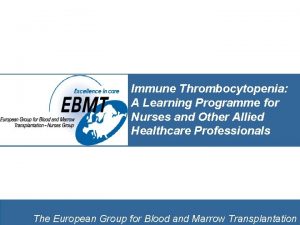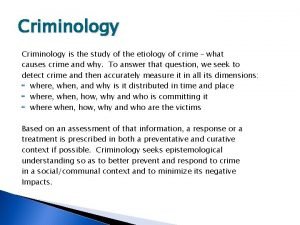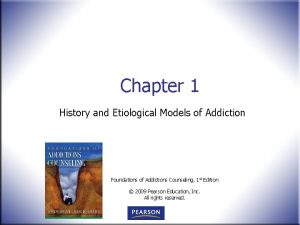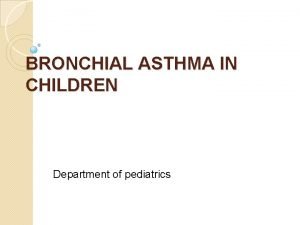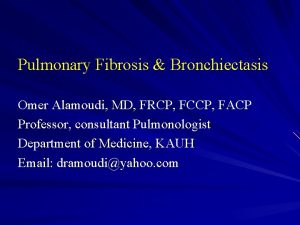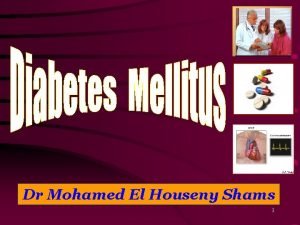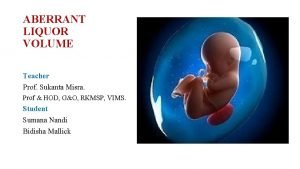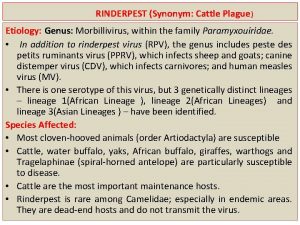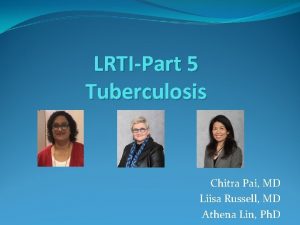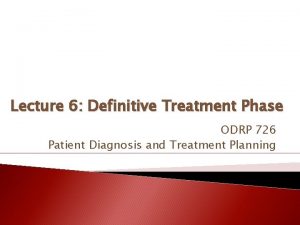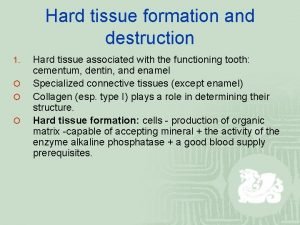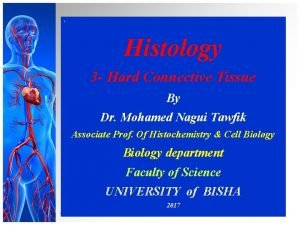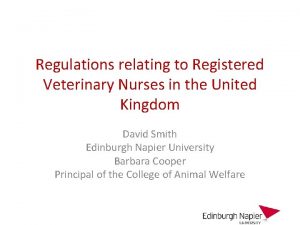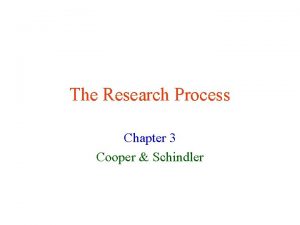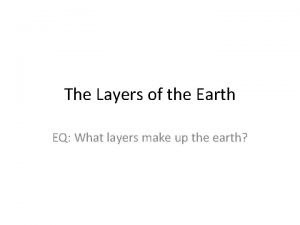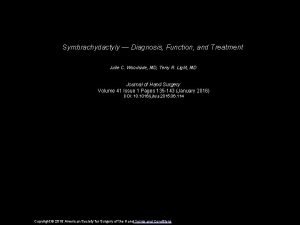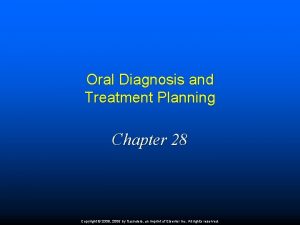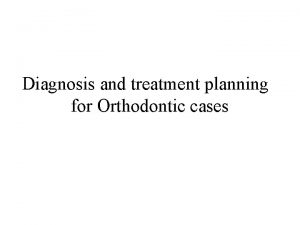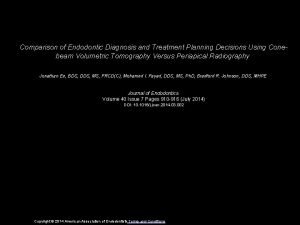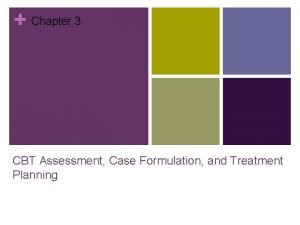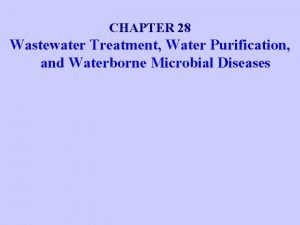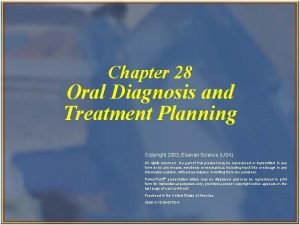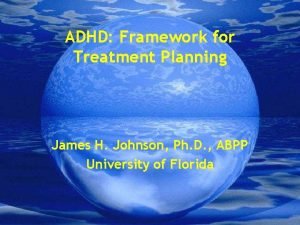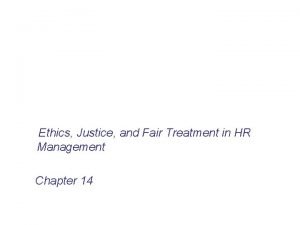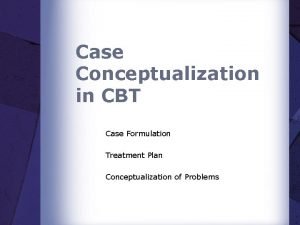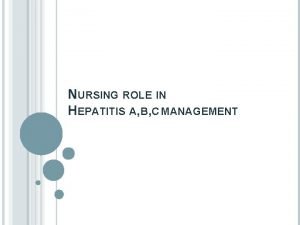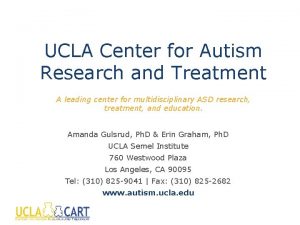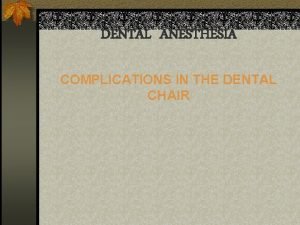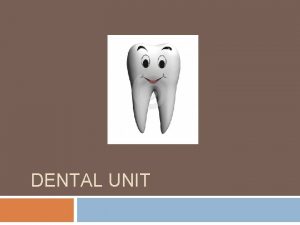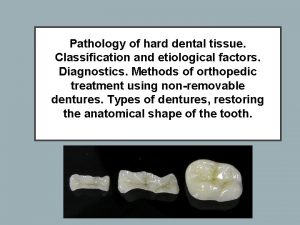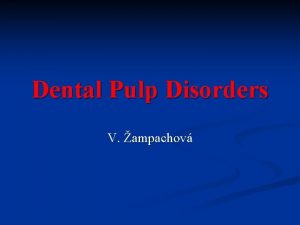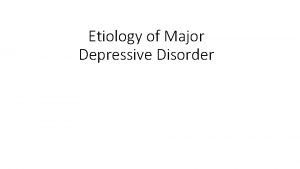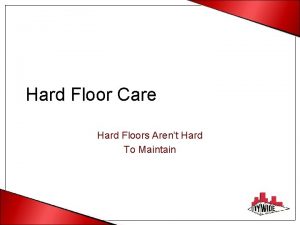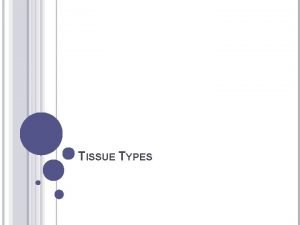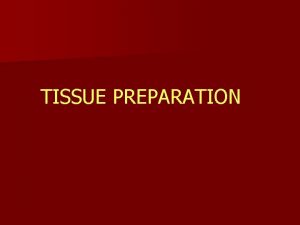DENTAL HARD TISSUE DISCOLOURATION ETIOLOGY AND TREATMENT 2014
















































- Slides: 48

DENTAL HARD TISSUE DISCOLOURATION. ETIOLOGY AND TREATMENT 2014. 04. 28. Dr. Déri Katalin

Tooth discolouration primary / permanent teeth enamel / dentin several possible causes during development / after eruption

Tooth discolouration External cause (extrinsic) üEnviromental factors üCan be removed Internal cause (intrinsic) üDeveloping before /meanwhile/after eruption

Extrinsic discolourations ü Non metallic stains : Tea, coffee, red wine, colourful fruits, tobacco, curry, saffron, soya sauce, fruit juice, candies, food containing clorophyll , mouthwashes containing chlorhexidine

Extrinsic discolourations ü Non metallic stains : Tea, coffee, red wine, colourful fruits, tobacco, curry, saffron, soya sauce, fruit juice, candies, food containing clorophyll , mouthwashes containing chlorhexidine

Extrinsic discolourations ü Non metallic stains : Tea, coffee, red wine, colourful fruits, tobacco, curry, saffron, soya sauce, fruit juice, candies, food containing clorophyll , mouthwashes containing chlorhexidine

Extrinsic discolourations ü Non metallic stains: Tea, coffee, red wine, colourful fruits, tobacco, curry, saffron, soya sauce, fruit juice, candies, food containing clorophyll , mouthwashes containing chlorhexidine

Extrinsic discolourations ü • • Non metallic stains : Gram-positive bacteria- Bacteroides Melaninogenicus Black stain in a line in parallel with the gingiva Hydrogen sulphide Iron sulphide (black)

Extrinsic discolourations ü • • Non metallic stains : Chromogenic bacteria- Serratia Marcescens Presence of the bacteria + Amoxicillin (long term) extrinsic factor Presence of the bacteria during tooth development intrinsic factor

Extrinsic discolorations ü Non metallic stains: Greenish discoloration ü ü poor oral hygiene→bacteria+inflamed bleeding gingiva (hemoglobin) Orange discoloration Labial surface of anterior teeth ü Unknown origin ü

Extrinsic discolourations § ü Metallic stains - factors: Rare in childhood Environmental factors ü ü Mouthwashes containing metals ü ü water-, air pollution Zinc, Stannous fluoride Medication containing iron

Metallic stains Iron, magnesium, silver– black pigmentation Mercury –grey or green pigmentation Lead – grey pigmentation Copper – brown or green pigmentation Bromides – brown pigmentation Nickel – green pigmentation Cadmium – yellow pigmentation Potassium – violet pigmentation

External (extrinsic) discolourations Therapy: ü Scaling ü Polishing ü Improving oral hygiene

Internal (intrinsic) discolourations Discolourations developed before /during eruption ü Turner-tooth ü Tetracycline caused discolouration ü Fluorosis ü MIH ü Neonatal hyperbilirubinaemia ü Erythroblastosis foetalis ü Porphyria ü Amelogenesis Imperfecta ü Dentinogenesis Imperfecta ü Thalassaemia

Turner-tooth Formal and structural anomaly of the germ of permanent incisor /canine/premolar ü ü Causes: Periapical inflammation of the primary tooth close to the developing germ Traumatic injuries of primary incisors (intrusion)

Turner-tooth

Tetracycline caused discolouration Tetracycline medication in the second half of the pregnancy striped discolouration of primary and permanent teeth Tetracyclin medication under the age of 8 primary and permanent teeth discolouration Higher dosage more severe discolouration Binds to Ca-, Mg-, Fe-, Al- chelates High dose→hypoplasia Light enhances the discolouration No tetracycline during pregnancy and under the age of 8!!!

Tetracycline caused discolourations Stages : 1. 2. 3. Light yellowish brownish greyish discolouration → can be bleached easily More intensive discolouration→ can be bleached Dark yellow/grey/bluish striped discolouration→ hardly can be bleached

Tetracyclin caused discolouration

Fluorosis Functional anomaly of ameloblasts, developing during tooth development because of too much fluoride intake Anomaly of: � � � ü ü Enamel crystallization Enamel development Enamel maturation Severity depends on: Amount of absorbed fluoride Time of exposition Stage of tooth development Individual sensitivity

Fluorosis Stages depending on the fluoride content of the water Mild: 2 ppm Medium: 3 -5 ppm Severe: 5 -6 ppm • • 1. 2. 3. 4. 5. 6. Normal At issue Very mild Medium Severe 1 2 3 4 5 6

Fluorosis Causes: • Toothpastes fluoride content and amount should based on the age • Some food: mushroom, seafood • Mineral water , black tea • Fluoride medication • Amoxicillin increases the risk of fluorosis 2, 5 x 1. 2. 3. 4. Very mild Medium Severe 1 2 3 4

Fluorosis Therapy: ü Microabrasion ü Remineralisation ü Regular check -ups ü Conservative or prosthodontic treatment

Molar and incisor hypoplasia (MIH) Anomaly of enamel matrix development Symmetric anomaly of teeth developing at the same time ( first molar-first incisor) Molars: § yellowish colour, § irregular shape, § underdeveloped cusps, § no visible enamel right after eruption Incisors : § brownish –yellowish inciso-labial surface § lack of enamel

Molar and incisor hypoplasia (MIH) Definitive cause: unknown Possible causes: � � malnutrition Celiac disease Neonatal hypoxia, Acute absorption disorders, urinary infections, asthma bronchiale, otitis media, scarlate fever , parotitis, chemotherapy, antibiotics

Molar and incisor hypoplasia (MIH) ü ü Therapy: Temporary – glass ionomer or compomer build-up Definitive – prosthodontic therapy

Neonatal hyperbilirubinaemia Bilirubin biliverdin subsides in the enamel /dentin of developing primary teeth Greenish-greyish teeth Can be lighter in time

Erythroblastosis foetalis Rh factor incompatibility in new-borns haemolysis haemosiderin dentin brownish/bluish/greenish discolouration

Porphyria Hereditary disorder of haemoglobin metabolism Primary and permanent teeth Redish –brownish tooth discolouration that turns violet for ultraviolet light

Amelogenesis imperfecta ü ü ü Hereditary disease Disorder of enamel formation Normal dentin structure 3 types: Hypoplastic type Hypocalcification type Hypomatured type

Amelogenesis imperfecta Hypoplastic type Disorder of organic matrix formation of the enamel Enamel is thin , discoloured, fast abrasion , pits on the surface Small amount of enamel no contact points

Amelogenesis imperfecta Hypocalcification type Thickness of the enamel: normal or thinner Fragile, soft Discolouration: opaque-yellowbrown Disorder of crystallization of the organic matrix of the enamel

Amelogenesis imperfecta Hypomatured type Disorder of maturation of the crystallized enamel matrix Fragile , removable enamel Tooth colour: white, yellow, brown

Amelogenesis imperfecta § § § Enamel disorder higher risk for caries Higher sensitivity for heat and cold Therapy: improving oral hygiene preventive treatments conservative/prosthodontic treatment

Dentinogenesis imperfecta Hereditary developmental disturbance of dentin Poor quality dentin discoloured teeth, enamel breaks easily Dentin not covered with enamel abrasion, caries In primary dentition - more frequent Teeth are redish-brownish-bluish 3 types

Dentinogenesis imperfecta I. type – accompanied by osteogenesis imperfecta, the pulp chamber is smaller than normal II. type – no bone defect, only the dentin is involved, pulp chamber is smaller than normal III. (Brandywine) type – most severe , pulp chamber is big, can be reached easily, short roots, round apex

Dentinogenesis imperfecta Father’s teeth B Neeti. Dentinogenesis Imperfecta – “A Hereditary Developmental Disturbance of Dentin”. The Internet Journal of Pediatrics and Neonatology. 2010 Volume 13 Number 1.

Dentinogenesis imperfecta Son’s teeth B Neeti. Dentinogenesis Imperfecta – “A Hereditary Developmental Disturbance of Dentin”. The Internet Journal of Pediatrics and Neonatology. 2010 Volume 13 Number 1.

Dentinogenesis imperfecta Therapy: Main problem: abrasion, caries functional and esthetic issues conservative or prosthodontic treatment

Thalassaemia Hereditary (autosomal , recessive) haemolytic anaemia Bluish –brownish-greenish discolouration

Internal (intrinsic) discolourations Developed after eruption ü Necrosis (gangraena) ü Traumatic injuries caused discolouration ü Pulp resorption ü Internal granuloma ü Chemicals caused discolouration

Necrosis (gangraena) Necrotized pulp tissue degeneration discolouration Therapy: RCT, bleaching / extraction

Discolouration caused by trauma Trauma bleeding in the pulp chamber pink discolouration can heal spontaneously More severe cases necrosis greyish/brownish

Discolouration caused by trauma Therapy: RCT, bleaching

Internal resorption of the pulp Trauma secondary, tertiary dentinogenesis in the pulp chamber Pulp chamber obstruction Yellowish/ivory discolouration Vitality kept Therapy: primary teeth – no need for therapy, permanent teeth – bleaching (age!)

Internal granuloma Trauma dislocated tooth internal granuloma Chronic inflammation of the pulp tissues widening in a circle within the pulp chamber Violet-pink discolouration Spontaneous crown fracture

Internal discolourations caused by chemicals Dental materials E. g. : amalgam, N 2, Endomethason, AH, iodoform -based sealer, Ledermix Therapy: Primary– no treatment � Permanent- bleaching (age!) �

Thank you for your attention!!!
 Difference between nursing bottle caries and rampant caries
Difference between nursing bottle caries and rampant caries Itp and dental treatment
Itp and dental treatment Etiology in criminology
Etiology in criminology Etiological models of addiction
Etiological models of addiction Mild moderate severe asthma exacerbation
Mild moderate severe asthma exacerbation Pathology of asthma
Pathology of asthma Etiology of appendectomy
Etiology of appendectomy Pes statement example
Pes statement example Etiology
Etiology Etiology synonym
Etiology synonym Etiology
Etiology Who classification of periradicular diseases
Who classification of periradicular diseases Oligohydramnios management
Oligohydramnios management Tccdtccd
Tccdtccd Etiology synonym
Etiology synonym Site:slidetodoc.com
Site:slidetodoc.com Chitra pai
Chitra pai Phases of dental treatment planning
Phases of dental treatment planning Advantages and disadvantages of rpd
Advantages and disadvantages of rpd Perforation plates
Perforation plates Osteblasts
Osteblasts Hard connective tissue
Hard connective tissue Gravimetric analysis of calcium and hard water
Gravimetric analysis of calcium and hard water Work hard. have fun. make history
Work hard. have fun. make history Hard times hard drive
Hard times hard drive Social services and wellbeing act easy read
Social services and wellbeing act easy read Social services and wellbeing (wales) act 2014 easy read
Social services and wellbeing (wales) act 2014 easy read Veterinary nurse conduct and discipline rules 2014
Veterinary nurse conduct and discipline rules 2014 Nora schindler
Nora schindler Salient features of rte 2009
Salient features of rte 2009 Eft payment bangladesh
Eft payment bangladesh Hard and rigid the earth's outermost and
Hard and rigid the earth's outermost and Trauma awareness and treatment center utah
Trauma awareness and treatment center utah Julie woodside
Julie woodside Charting exercise chapter 28
Charting exercise chapter 28 Orthodontic cases and treatment plan
Orthodontic cases and treatment plan Neil classification lateral throat form
Neil classification lateral throat form Endodontic diagnosis and treatment planning
Endodontic diagnosis and treatment planning Cbt case formulation
Cbt case formulation Sewage treatment primary secondary and tertiary
Sewage treatment primary secondary and tertiary Oral diagnosis and treatment planning ppt
Oral diagnosis and treatment planning ppt Treatment plan goals for adhd
Treatment plan goals for adhd Ethics justice and fair treatment in hrm
Ethics justice and fair treatment in hrm Case conceptualization cbt
Case conceptualization cbt Care and treatment reviews
Care and treatment reviews Assessment and treatment alternatives
Assessment and treatment alternatives Chapter 1 risk and its treatment
Chapter 1 risk and its treatment Hepatitis b causes
Hepatitis b causes Ucla autism center
Ucla autism center

